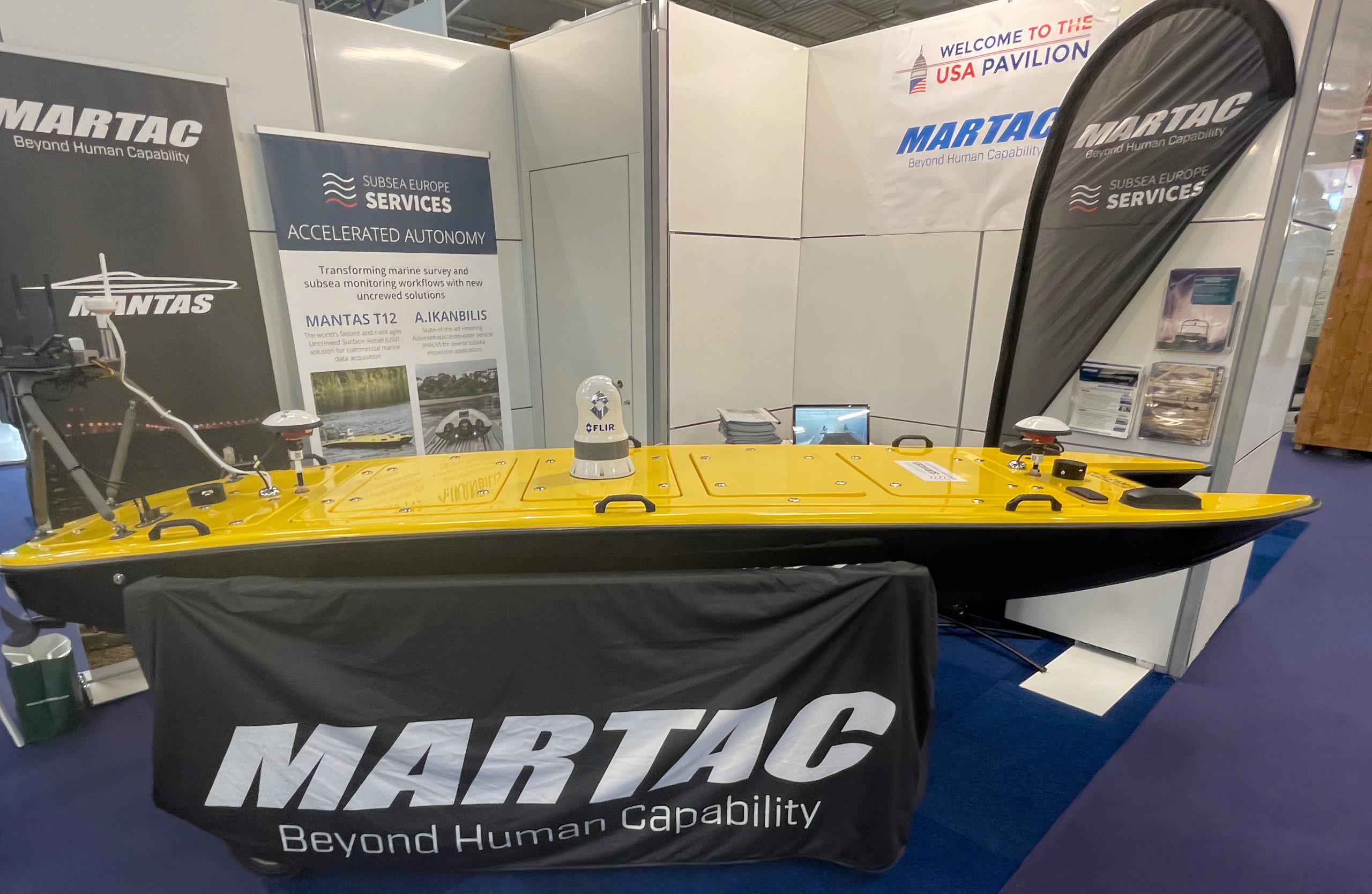By Pierre Tran
Paris – MARTAC, a private U.S. company, displayed its Mantas uncrewed surface vessel (USV) for the first time at the Euronaval trade show, which opened Oct. 18. at Le Bourget, just outside the capital.
A civil version of the Mantas T12 vessel in distinctive bright yellow and fitted for autonomous operations in search and survey missions was presented at the show.
The vessel was equipped with a sonar system for exploring the seabed and detecting objects, said Daniel Esser, managing director of Subsea Europe Services, the European partner of MARTAC. Subsea Europe is based in Hamburg, northern Germany.
That version of the 3.6-meter long Mantas T12 carried two INS systems for high precision navigation and a Flir camera for infrared optical viewing. Other cameras could be fitted, depending on operational need, which included military missions.
More than 30 USVs have operated in Australia, Bahrain, New Zealand, the U.K., and the U.S., said Bruce Hanson, chief executive of Maritime Tactical Systems, based in Melbourne, FL.
“MARTAC has been working with military and commercial customers for years in not only experiments, but real-world operations,” he said. “This constant feedback has shaped the capabilities of our advanced USV solutions.”
U.S. special forces have taken trial vessels and made them fully operational, he said.
The vessels have been used for intelligence, surveillance and reconnaissance, and logistical support. In one case, an uncrewed boat was used for medical evacuation of two injured personnel, accompanied by two medical staff, from their ship to a larger ship.
The U.S. navy has used the USV for ship-to-ship and ship-to-shore operations in Guam, and delivered medical supplies for the Fifth Fleet in Bahrain, he said.
The larger Devil Ray uncrewed boat, powered by gas or diesel fuel, can carry eight to 12 passengers, and can hit top speed of more than 80 knots. A chase boat can be fitted with a canopy to protect personnel on board, while other versions can be used for detecting mines or mine laying offensives.
These uncrewed boats can be used for tactical military missions, and could be “weaponized,” he said.
The USVs could be deployed in swarms, with dozens of vessels operating in full autonomy to overwhelm conventional, crewed ships. The U.S. navy has included USVs in war games, showing potential deployment of swarms of hundreds of uncrewed boats.
Some countries are using the USV for narcotics seizure, operating night time surveillance. The vessels can lie almost below the water, making them hard to see.
Tests of the Mantas T12 in Europe have been conducted in the Baltic and North Sea, Esser said.
The results have been “very satisfying,” he said. The plan was to have three of the vessels in Europe next year, five in 2024, and 10 in 2025.
The aim is to develop the vessel, to add artificial intelligence and increase autonomy. The civil version on display could operate for up to eight hours at sea, with two or three sets of batteries on board, located under a flush panel toward the vessel’s bow.
There is development work to give greater endurance and faster charging of the battery packs.
The Mantas T12 hull is made of carbon fiber, and is based on an aerodynamic laminar flow design to give a high level of stability, Hanson said. The boat went on sale in 2019, just as the Covid pandemic hit.
Some $12 million has been invested on research on the USV hull. The Mantas uses a catamaran hull.
No financial details were available for the company.
There was potential for the company to raise capital, but only if that were needed, Hanson said.
There are three versions of the Devil Ray USV, with the 11.1-meter long T38 model due to enter full production in the first quarter 2023, the company website shows. The T24 model, measuring 7.2 meters, is also due in the first quarter 2023.
The T50 model, with a length of 15.2 meters, is in pre-production, and is the version with the highest speed of more than 80 knots, depending on the propulsion configuration and payload.
Editor’s Note: This is the first of our reports from the Euronaval show with more to follow in coming days.
Building a Platform for Wolfpack Unmanned Surface Vessel Kill Web Operations
Delivering Mission Capabilities to the Fleet via USVs: From Platforms to the Payloads


